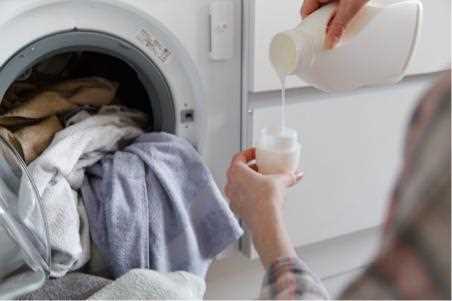




When shopping for a washing machine, one of the specifications that you will often come across is the capacity. But what exactly does this capacity refer to? Does it mean the amount of wet clothes the machine can handle, or does it refer to dry clothes? This is a common question that many consumers have, and it’s important to understand the difference to ensure that you choose the right machine for your needs.
In most cases, the capacity of a washing machine refers to the amount of dry clothes that can fit in the drum. This means that if a machine has a capacity of 8kg, it can effectively wash 8kg of dry clothes in one cycle. However, it’s important to note that this capacity can vary depending on the type of fabric and the amount of water retained in the clothes after a spin cycle.
It’s worth mentioning that washing machines are designed to accommodate a certain amount of space for the clothes to move around and get cleaned properly. So, while it may be tempting to stuff the machine to its maximum capacity, it’s generally recommended to leave some room to ensure that the clothes are cleaned thoroughly. Overloading the machine can lead to less effective cleaning and potentially damage to the machine.
In conclusion, when you see the capacity specification of a washing machine, it usually refers to the amount of dry clothes that can be washed in one cycle. It’s important to consider factors such as the type of fabric and the amount of water retained in the clothes when determining the appropriate load size. Remember to leave some room in the machine for proper cleaning and to avoid overloading the machine. By understanding the capacity specifications, you’ll be able to make an informed decision and choose a washing machine that meets your needs.
Understanding Washing Machine Capacity: Wet vs Dry Washing
When it comes to understanding washing machine capacity, it is important to differentiate between wet and dry washing. Washing machine capacity refers to the amount of laundry that the machine can accommodate in a single wash cycle. However, there can be confusion regarding whether this capacity refers to wet or dry laundry.
Wet Washing Capacity

The most common interpretation of washing machine capacity is the wet washing capacity. This refers to the weight of laundry that the machine can handle when it is wet, after the clothes have been soaked in water. Wet washing capacity takes into account the additional weight of water absorbed by the clothes during the washing process.
For example, if a washing machine has a wet washing capacity of 8 kilograms, it means that it can wash up to 8 kilograms of clothes when they are wet and soaked in water.
Dry Washing Capacity
On the other hand, dry washing capacity refers to the weight of laundry that the machine can handle when the clothes are dry. This capacity does not take into account the additional weight of water. Dry washing capacity is less commonly specified by manufacturers, as the wet washing capacity is generally more relevant for most users.
It is important to note that when it comes to determining the amount of laundry to load into a washing machine, it is advisable to follow the manufacturer’s guidelines and recommendations. Overloading the washing machine with either wet or dry laundry can lead to inefficient cleaning, excessive wear and tear on the machine, and potential damage.
Choosing the Right Capacity
When purchasing a washing machine, it is essential to consider your laundry needs and lifestyle. If you frequently wash large loads or have a large household, it may be advisable to choose a washing machine with a higher wet washing capacity. However, if you tend to wash smaller loads or have a smaller household, a machine with a lower wet washing capacity may be sufficient.
Additionally, it is worth considering the energy and water efficiency of the washing machine. While larger capacity machines may be able to handle more laundry, they may also consume more energy and water. Therefore, it is important to strike a balance between capacity and efficiency based on your specific needs and usage patterns.
| Capacity | Load |
|---|---|
| Small | Up to 6 kg wet weight |
| Medium | 7-9 kg wet weight |
| Large | 10+ kg wet weight |
It is important to note that the capacity guidelines may vary slightly between different manufacturers, so it is always advisable to consult the specific guidelines provided by the washing machine manufacturer.
By understanding the difference between wet washing capacity and dry washing capacity, you can make a more informed decision when it comes to purchasing and using a washing machine that best suits your laundry needs. Remember to always refer to the manufacturer’s guidelines for loading capacity and maintain proper care and maintenance for optimal performance of your washing machine.
What Does Washing Machine Capacity Mean?

When shopping for a washing machine, you may come across the term “washing machine capacity.” But what exactly does this mean? Washing machine capacity refers to the amount of laundry that the machine can hold and wash in a single cycle.
Washing machine capacity is typically measured in kilograms (kg). This measurement represents the weight of dry clothes that the machine can accommodate. It is important to note that the capacity does not include the weight of water or detergent.
Understanding the capacity of a washing machine is crucial to ensure that you can wash as much laundry as needed without overloading the machine. Overloading a washing machine can lead to poor cleaning results, longer wash times, and even damage to the machine.
Factors to Consider when Determining Washing Machine Capacity
There are several factors to consider when determining the appropriate washing machine capacity for your needs:
- Household Size: The number of people in your household will influence the amount of laundry you generate. For smaller households, a washing machine with a lower capacity may suffice. However, larger households may require a machine with a higher capacity to handle their laundry needs.
- Type of Clothing: The type of clothing you frequently wash can also impact the washing machine capacity you require. Heavier items such as jeans and towels may take up more space in the machine compared to lighter materials like shirts and underwear. If you frequently wash large and heavy items, it may be beneficial to opt for a washing machine with a larger capacity.
- Frequency of Use: How often you plan on using the washing machine can also play a role in determining the capacity. If you do laundry more frequently, a machine with a smaller capacity may be suitable. Alternatively, if you prefer to do laundry less often, a machine with a larger capacity can help you wash more clothes in a single cycle.
Understanding the Impact of Washing Machine Capacity

Choosing the right washing machine capacity is essential for efficient and effective laundry care. If you consistently overload a washing machine, it may not thoroughly clean your clothes or adequately rinse away detergent residue. On the other hand, a machine with too large of a capacity may consume excessive amounts of water and energy for smaller loads.
By selecting a washing machine with an appropriate capacity for your household needs, you can ensure optimal cleaning performance, water, and energy efficiency. It is recommended to check the product specifications provided by manufacturers and consider your laundry habits before making a final decision.
Wet Washing vs Dry Washing: Knowing the Difference
Understanding the difference between wet and dry washing is vital when it comes to considering washing machine capacity. Many people wonder whether the capacity refers to wet or dry washing. Let’s break it down.
Wet Washing
Wet washing refers to clothing or fabrics that have water in them. This includes clothes or items that have been soaked or submerged in water, such as after a workout or a spill. When you wash wet clothes, the water adds weight to the load, increasing the overall volume and making it heavier.
Dry Washing
Dry washing, on the other hand, refers to clothing or fabrics that are completely dry and do not have any water in them. Dry clothes are typically fresh out of the dryer or freshly washed and hung up to dry. When you wash dry clothes, they do not add any additional weight to the load, as they are already in their final state.
It is important to note that washing machine capacity usually refers to dry washing. This means that the capacity stated on the machine refers to the amount of dry clothes that can be washed in a single load.
How to Determine Washing Machine Capacity
To determine the washing machine capacity, you should consider the weight of the dry clothes that the machine can handle. Typically, washing machine capacities are given in kilograms, representing the weight of the dry clothes that can be washed in one load.
However, it is worth noting that when wet washing is added to the machine, it will increase the weight of the load and may affect the overall performance and efficiency. It is recommended to avoid overloading the machine and to follow the manufacturer’s guidelines for the maximum weight of wet clothes that can be safely washed in a single load.
Conclusion

In conclusion, washing machine capacity refers to the amount of dry clothes that can be washed in one load. Wet washing adds water weight to the load, increasing the overall volume and making it heavier. It is important to consider the difference between wet and dry washing when determining the machine’s capacity and avoid overloading it with wet clothes.
By understanding the difference between wet and dry washing, you can make more informed decisions when doing laundry and ensure that your washing machine operates efficiently and effectively.
How Washing Machine Capacity Influences Wet Washing

When it comes to washing machines, the capacity of the machine refers to the amount of laundry it can hold. However, it is important to note that the capacity mentioned usually refers to dry washing instead of wet washing. This can often lead to confusion among users, as wet clothes tend to take up more space than dry clothes.
The capacity of a washing machine is typically measured in kilograms (kg) or pounds (lb), and it determines the maximum weight of clothes that can be washed in a single load. It is important to consider the capacity of a washing machine when purchasing one, as it can greatly impact the efficiency and convenience of doing laundry.
Factors to consider when choosing the appropriate washing machine capacity:
- Family size: The size of your family will play a crucial role in determining the washing machine capacity you need. Larger families with more members will generally require a machine with a higher capacity to accommodate the increased amount of laundry.
- Frequency of washing: If you find yourself doing laundry frequently and washing larger loads, a washing machine with a higher capacity would be beneficial. This will reduce the number of loads needed and save both time and energy.
- Types of fabrics: Certain fabrics, such as towels and jeans, are heavier and bulkier when wet. If you regularly wash these types of fabrics, it is recommended to choose a washing machine with a higher capacity to ensure that they can be properly cleaned.
It is important to note that overloading a washing machine can lead to issues such as poor cleaning results, excessive wear and tear on the machine, and even potential damage to the drum. Therefore, it is always better to have a bit of extra capacity than to constantly overload the machine.
Conclusion:

Understanding how washing machine capacity influences wet washing is essential for choosing a machine that will suit your needs. Consider factors such as family size, frequency of washing, and types of fabrics when selecting the appropriate capacity. By choosing the right capacity, you can ensure efficient and effective cleaning of your laundry while prolonging the lifespan of your washing machine.
How Washing Machine Capacity Affects Dry Washing
When it comes to washing machine capacity, it is important to consider its impact on dry washing. The capacity of a washing machine refers to the maximum weight of dry clothes that can be loaded into the machine at one time. This capacity plays a crucial role in determining the efficiency and effectiveness of the washing process.
A higher capacity washing machine allows for larger loads of dry clothes to be washed at once. This means that more clothes can be cleaned in a single cycle, saving time and energy. However, it is essential to note that overloading the washing machine can lead to poor washing performance and damage to both the machine and the clothes.
Advantages of a Higher Washing Machine Capacity for Dry Washing
- Efficiency: With a larger capacity washing machine, you can wash more clothes in a single cycle. This reduces the number of cycles required to clean all your laundry, resulting in energy and water savings.
- Time-saving: The ability to wash larger loads of dry clothes means that you can spend less time doing laundry. This is especially useful for busy households or individuals with a high volume of laundry.
- Convenience: A higher capacity washing machine allows you to clean bulkier items such as comforters, blankets, and curtains, which may not fit in a smaller capacity machine. This makes it easier to keep larger household items clean and fresh.
Considerations for Washing Machine Capacity and Dry Washing
While a larger capacity washing machine offers numerous advantages, there are a few factors that need to be taken into consideration:
- Space: Washing machines with larger capacities are generally bigger in size. Ensure that you have enough space in your laundry area to accommodate the machine comfortably.
- Budget: Washing machines with higher capacities tend to be more expensive. Consider your budget and the value you place on the convenience and efficiency of a larger capacity machine.
- Personal Preference: Some individuals may prefer smaller capacity machines to ensure careful washing of delicate items or to have more control over the washing process. Evaluate your personal requirements before selecting a washing machine capacity.
Ultimately, the capacity of a washing machine plays a significant role in dry washing efficiency and convenience. By understanding the advantages and considerations of different capacities, you can make an informed decision and select a washing machine that best suits your needs.
Tips for Choosing the Right Washing Machine Capacity for Your Needs
1. Consider your laundry habits
Before choosing a washing machine capacity, it’s important to consider your laundry habits. Think about how often you do laundry and how many clothes you typically wash in one go. This will help you determine the appropriate capacity that meets your needs.
2. Assess your living situation
Take into account the size of your household and the available space in your laundry area. If you have a large family or consistently have a large amount of laundry, a washing machine with a higher capacity may be more suitable. On the other hand, if you live alone or have limited space, a smaller capacity may be sufficient.
3. Factor in the types of clothes you wash
Consider the types of clothes you typically wash. If you frequently wash bulky items such as bedding or large towels, you may need a washing machine with a larger capacity to accommodate these items. However, if you mainly wash small or delicate garments, a smaller capacity may be suitable.
4. Evaluate energy efficiency
Keep in mind that larger washing machines generally consume more energy. If energy efficiency is a priority for you, consider opting for a washing machine with a smaller capacity. This can help reduce your energy consumption and lower your utility bills in the long run.
5. Balance your budget
Lastly, consider your budget when choosing a washing machine capacity. Larger capacity machines tend to be more expensive. Determine how much you are willing to spend and find a balance between capacity and affordability that meets your needs and budget.
Conclusion
Choosing the right washing machine capacity depends on factors such as your laundry habits, living situation, types of clothes you wash, energy efficiency, and budget. By considering these factors, you can select a washing machine with the optimal capacity that best suits your needs.
FAQ
What does washing machine capacity refer to?
Washing machine capacity refers to the maximum weight of laundry that the machine can hold during a wash cycle.
Does washing machine capacity refer to the weight of wet or dry laundry?
Washing machine capacity typically refers to the weight of dry laundry. However, some manufacturers may specify the capacity based on wet laundry weight.
Why is it important to know if washing machine capacity refers to wet or dry washing?
Knowing whether washing machine capacity refers to wet or dry washing is important because it determines the amount of laundry that can be washed in a single load. If the capacity refers to wet washing, then you may need to adjust the amount of laundry you put in the machine to avoid overloading it.
Can I exceed the washing machine capacity if it refers to dry washing?
It is not recommended to exceed the washing machine capacity, even if it refers to dry washing. Overloading the machine can put strain on the motor and decrease the effectiveness of the wash. It is best to follow the manufacturer’s guidelines for load capacity.
How do I determine the weight of my laundry to match the washing machine capacity?
To determine the weight of your laundry, you can use a bathroom scale. Weigh yourself holding the laundry, then weigh yourself without it and subtract the difference. This will give you an estimate of the weight, allowing you to match it with the washing machine capacity.
Does washing machine capacity refer to wet or dry washing?
Washing machine capacity refers to the maximum weight of dry clothes that can be loaded into the machine for a single wash cycle.











